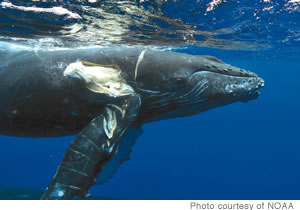Humpbacks: They’re Still Here

Wednesday - March 24, 2010
| Share
 Del.icio.us
Del.icio.us
|
Spring is here, but there are still remnants of what’s been a warm winter season in Hawaiian waters. The humpback whales have extended their annual visit beyond the winter months.
“We still have much activity,” says Christine Brammer, National Oceanic and Atmospheric Administration’s Hawaiian Islands Humpback Whale National Marine Sanctuary ocean count coordinator. “The season isn’t over yet.”
Although the peak season for humpback whales in Hawaii is from January through March, it’s not uncommon to see whales in Hawaiian waters until late May or even June. It appears that may be the case in 2010 - good news for whale watchers, but a reason to stay on alert.
The longer stay, combined with an increase in the number of whales in Hawaiian waters and an increase in ocean users, results in the potential for more whale-vessel contacts or collisions.
“There’s been an increase in animals to about 12,000, and certainly more boat traffic,” says Brammer. “There also has been a greater effort in encouraging reporting because there may have been strikes that went unrecorded prior to that.”
One of the more recent contacts happened Feb. 11 off Kailua Beach. A group of one-man canoe paddlers were several miles offshore when a whale unexpectedly surfaced on Keola Lindsey and his 20-foot canoe.
“I was going fast already and it was right there - it was no more than a couple feet away,” recalls Lindsey. “It reminded me of how big the ocean is and how we’re only guests out there.”
“We were riding swells back to shore and all of a sudden I heard this loud crack, and I glanced sideways and I saw Keola and the boat upside down flying in the air,” recalls Wendell Balai. “It’s a good thing the whale didn’t come up head-first into Keola. It could have been bad.”
Lindsey’s boat suffered extensive damage, but he was not injured. He was forced to abandon his vessel at sea and caught a ride back to shore with another paddler - startled, but alive.
“I was very lucky and very fortunate that I had people to help me,” says a grateful Lindsey. “I consider it a miracle.”
Brammer says humpback whale calves are most at risk of being struck by a vessel because they spend a considerable amount of time at or near the surface to breathe. Most calves take a breath every three to five minutes.
“They also have no experience navigating around boats,” she adds.
According to NOAA data, between 1995 and 2003 there were 13 reported collisions in Hawaiian waters. Over the past few seasons, an average of six to 10 confirmed reports have been received annually.
So what should you do in the event of a whale-vessel contact? Officials say do not hesitate to call the NOAA marine mammal hotline at 1-888-256-9840.
Investigations are opened by NOAA’s Office for Law Enforcement. A state-level investigation also is opened under the state’s wildlife protection law and, in some cases, an additional investigation may be conducted by the U.S. Coast Guard.
NOAA officials remind boat operators to watch their speed and never try to cut off or get ahead of a whale. Research shows collisions occurring at vessel speeds above 10 knots cause more whale deaths and serious injuries than collisions occurring at slower speeds.
“The main message is to be aware and prepared,” reminds Brammer.
Kailua paddlers are certainly on alert after learning a valuable lesson on human nature and Mother Nature.
“She (Mother Nature) showed us, ‘You know what, you guys are just manini compared to what I surround you with,’” says paddler Wally Hamasaki of Kailua. “It was a wake-up call.”
The final whale count for 2010 is scheduled for March 27. For more information, visit http://www.sanctuary-oceancount.org.
E-mail this story | Print this page | Comments (0) | Archive | RSS Comments (0) |
Most Recent Comment(s):













